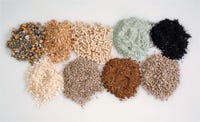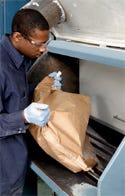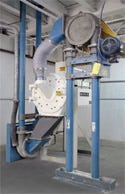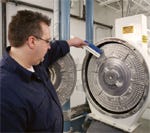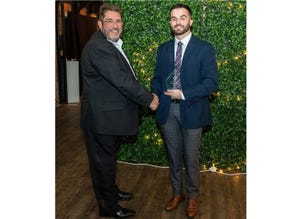Pesticide Manufacturer Meets Blend Regulations with Rotary Batch Mixers
April 23, 2008
|
A sampling of Bonide’s solid pesticides and herbicides, which range from granules to dust. |
When Bonide Products Inc. moved into new and larger facilities, an important consideration was the selection of mixing equipment for its granular and powdered pesticides and herbicides. “Our business is pretty heavily regulated by the (U.S.) Environmental Protection Agency and by the states,” says Jim Wurz, president, “and we have to meet a guaranteed analysis for our products. If we don��’t have a homogeneous mix and they test a sample that doesn’t meet the standard, we’re in trouble.”
The company apparently made the right choices, since its annual sales have been growing “in double digits” since the move, according to Wurz. As for meeting standards, Bonide has “never had a problem with product quality for at least 20 years that I know of,” he says.
Founded by Wurz’s grandfather and great uncle in 1926, Bonide formulates 120 to 150 pesticides, herbicides, and related products in granular or dust form and a similar number of liquid products. These products are sold through garden shops and other stores throughout the U.S. Maintaining consistent quality is trickier for solid than for liquid products because it is more difficult to obtain an even mix of several components whose representation in a batch ranges from kilograms to a few grams.
|
An access panel on the side of the rotary batch mixer provides easy access for personnel to perform cleaning and maintenance. |
Bonide strives to maintain quality by adhering to strict process control. Diluent or carrier materials such as corn cob, clay, vermiculite, limestone, and talc are received in truckloads and pneumatically blown into silos that are located outside the production building. When a new batch is needed, the operator inputs the formula into the process control computer, and the amount of the desired carrier material is pneumatically conveyed to a rotary batch mixer that is mounted on load cells. The computer stops the flow when the charge reaches the preset weight. Other ingredients, such as the active ingredient, buffers, surfactants, fillers, and pH adjusters, are weighed and added manually to the mixer. Again, the computer verifies that the necessary amounts have been added.
|
Fine powders are processed in this attrition mill (center left) and pneumatically conveyed to the packaging area via the blue tube at the left. |
Solid products are formulated as granules or dust (fine powder). Following the mixing operation, products designated as dust are transported pneumatically to an attrition mill that manufactures homogeneous fine powders—in some cases with particle sizes as small as a few microns. This product is transferred to a tote bin that serves the packaging line. Granular products go straight from the mixer to a tote bin. Except for the manual loading of lower-volume ingredients, the entire process is enclosed.
The mixing step is the heart of the process. Bonide uses four rotary batch mixers from Munson Machinery Company, Inc. (Utica, NY). Munson also supplied the attrition mill. Three of the machines, the Model 700-TH-50-MS, are identical and were bought when Bonide started up its new facility. These machines have a rated capacity of 50 cu ft and a total volume of 105 cu ft. The fourth machine is an older model with a rated capacity of 110 cu ft. The large machine and one of the smaller ones are used to mix granular materials, while the other two process dust products.
All the mixers have the same basic design. Each machine is a horizontal drum that rotates on two oversized trunion rings that are located at either end of the vessel. Each has a stationary inlet at one end and a stationary outlet and discharge gate at the other. Material is charged via the inlet chute while the vessel rotates. Mixing flights or baffles tumble the batch in a multidirectional manner while simultaneously moving the material toward the outlet.
|
A negative-pressure feed hopper is used to manually add small quantities of ingredients to the mixer. |
For its new facility, Bonide opted for the rotary batch mixers mainly because it has had good results with similar machines over many years. “In our experience, they produce a homogeneous mix in a short period of time and they are easy to clean,” says Wurz. “In the past, we have tried other mixers such as ribbon blenders and cone mixers, but we found that they either took a longer time to mix our products or were more difficult to clean.”
Wurz adds that rotary mixers have also proved to be reliable, noting that Bonide has had the older 110-cu-ft-capacity machine for about 30 years. “We have had to have new trunions put on it from time to time, but it still runs reliably.”
|
The interior of the attrition mill is easily accessible for cleaning and maintenance. |
Working one shift per day, five days a week, Bonide produces roughly 100,000 lb/week of granular and powder products. The mixers process average batch sizes of about 4000 lb for granular materials and 2000 lb for dust products. The optimum batch size is determined by the bulk density of the material, says Wurz, who adds that “mostly we try to run with a full load.”
While a batch is being mixed, liquid can be added to the particles via a tube running along the center of the machine that is equipped with multiple nozzles. In Bonide’s case, the liquid may be an active ingredient, a spreader-starter, or a dust-inhibitor. The liquid is stored in a small tank outside the machine.
Bonide uses several different nozzle sizes for different liquids. “You can set the nozzles for the spray pattern and the spray time that you want,” says Wurz. “The nozzles are set at strategic locations so that you get a good distribution of the spray. We try to work it so that we don’t change the nozzles too often, although it only takes about 20 minutes.”
|
This rotary batch mixer is one of three 50-cu-ft-capacity mixers used by Bonide Products. |
The time required to obtain a thorough mix is rarely more than 15 minutes, and the company schedules production runs so that a particular machine processes batches of the same or a similar product to avoid or minimize cleanings between batches. However, even when a complete cleaning is required, it rarely takes more than half an hour because the machine is easy to clean. “We rinse it with a solvent or sometimes just use the carrier material, and we clean out the nozzles by spraying a detergent through them,” says Wurz.
Dust products go to an attrition mill prior to packaging. The mill uses one stationary and one rotating disk to obtain a homogeneous fine-powder mix. “It gives us a finely ground product with a consistent particle size,” notes Wurz.
Bonide has 13 filling lines for its final products—three each for granular and dust products and seven for liquid products. Solid products are packaged mostly in 8-oz, 1-lb, and 4-lb plastic bottles, and a few are sold in 10-lb bags. The bottles are filled using single-head auger fillers, and the bags are filled using rotating buckets. Both bottles and bags are check-weighed individually by means of a load cell that is located on the conveyor line.
The company also has a small but growing business with contractors, to whom it sells products in 50-lb bags. “We are working to expand that business,” says Wurz, “and if things go as planned, we will probably need a couple of larger rotary mixers with capacities in the 10,000-lb range.”
Munson Machinery Company, Inc. manufactures mixers, blenders, and size-reduction equipment for bulk solid materials. For more information, call 800-944-6644 or visit www.munsonmachinery.com.
You May Also Like
